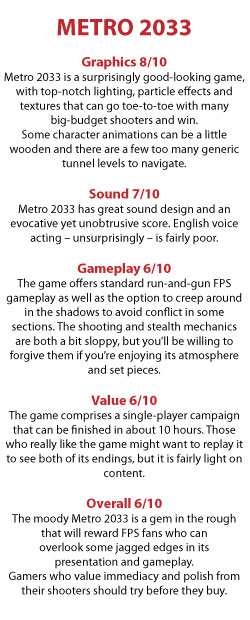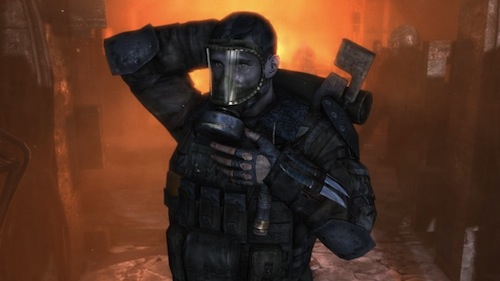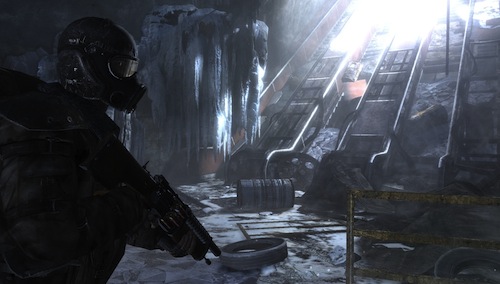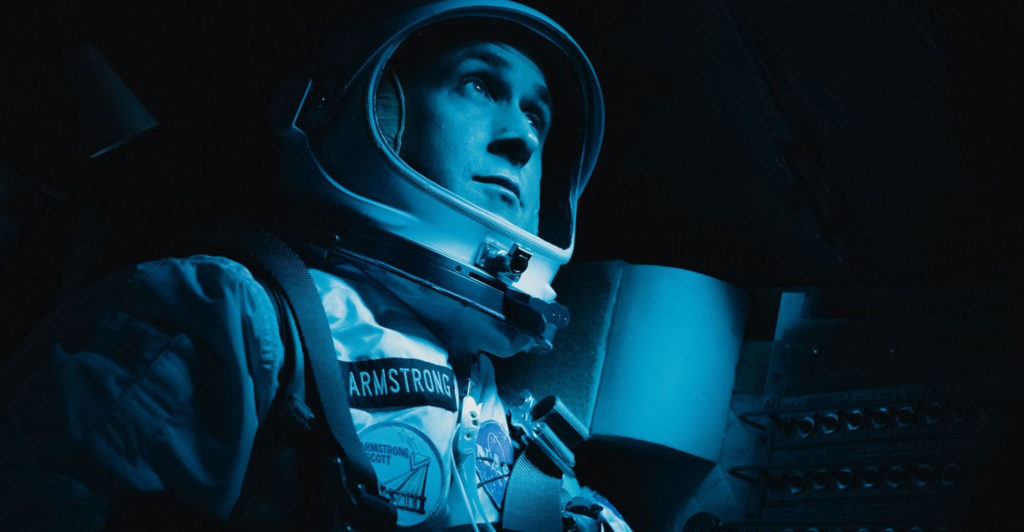[By Lance Harris, TechCentral]
Perhaps because it was developed in a country that still remembers the world’s worst nuclear disaster, Metro 2033, from Ukrainian developer 4A Games and publisher THQ, is one of the most chilling depictions of a post-apocalyptic world in a videogame yet. It’s a world so grim that its characters would probably welcome a holiday in Fallout 3’s wastelands.
4A Games is largely made up of people who worked on that other Ukrainian cult classic, Stalker: Shadow of Chernobyl. Metro 2033 has much in common with that game in terms of atmosphere and setting, though it’s a more linear first-person shooter (FPS) than the open-world Shadow of Chernobyl. And just like that game, Metro 2033 has quickly built up a small but rabidly devoted following for its unique setting and tough gameplay.
Based on a science-fiction novel by Dmitry Glukhovski, Metro 2033 is set in Russia in 2033 after a catastrophe has levelled most of the world to rubble and turned the earth’s surface into a poisonous, radioactive wilderness populated by mutants. You take the role of Artyom, a young man on a quest to save the people of his underground shelter from certain doom.
 No game has done a better job of creating an atmospheric, cohesive world for its characters to inhabit. It’s a world where high-grade bullets are so rare that they’re traded as a currency and where soldiers rely on crudely made guns and low-grade ammunition in most fire fights because decent equipment is scarce.
No game has done a better job of creating an atmospheric, cohesive world for its characters to inhabit. It’s a world where high-grade bullets are so rare that they’re traded as a currency and where soldiers rely on crudely made guns and low-grade ammunition in most fire fights because decent equipment is scarce.
Below the ground, you’ll be fighting your way through murky tunnels infested by ghosts, mutants and warring human Nazi and Red factions. Occasionally, you’ll stumble upon a friendly settlement in a metro station, where you’ll find hardened people barely hanging on to life, drinking vodka, cracking bleak jokes and selling livestock. The stink of desperation and defeat hangs in the air with the smoke from cooking fires.
And on the surface, you’ll need to wear a gas mask to survive the poisonous atmosphere. As Artyom, you peer at the world through a mask that cracks from combat damage and cakes up with condensation as he makes his way through the ashen, blighted landscape. You can almost feel the tightness of Artyom’s chest as he battles to breathe, almost feel the howling wind cutting through his clothes, thanks to the excellent audio design.
Pacing is superb, with the game sweeping the player through a range of varied set pieces and levels. The game features some memorable sequences that are as thoughtful as any you’ll see in Half-Life 2. One example is a section where Artyom has to navigate a monster-infested tunnel bearing a child on his shoulders. You’ll need to adjust your aim and movement to compensate for the kid’s weight — just one of the many inventive moments in the game.
Unfortunately, the gameplay in Metro 2033 doesn’t quite match up to the quality of the visuals, the narrative trappings and game world. The game is a hybrid between story-driven FPSs along the lines of Half-Life 2, corridor crawlers in the vein of the Fear games, and survival horror games such as Resident Evil.
At various points in the game, you’ll do battle with a range of human soldiers and mutated monsters using a selection of makeshift guns and explosives. And as in a survival horror game, you’ll be managing your resources carefully — watching that you don’t run out of filters for your gas mask, making sure that you keep your lamp and night-vision goggles charged, and counting every round that you fire.
The monsters will sniff you out in the dark, so running away or shooting are your only options.
When facing human enemies, you can usually stalk them from the shadows and get rid of them quietly with throwing knives and silenced firearms. Or you can run in with all-guns blazing.
The stealth and shooting gameplay mechanics can be equally frustrating in later parts of the game, where the difficulty level is cranked up. When it’s often less annoying to run through a level than to fight or sneak, a game like this is doing something wrong.
For example, hit detection and feedback are erratic, so you’re not always sure if you’re dealing damage to an enemy that you’re hitting with a barrage of gunfire. The stealth mechanics have some neat touches — for example, standing on broken glass will alert enemies as surely as will walking through a well-lit area — but they’re also horribly unforgiving.
Though most of its rival games try to challenge players with thoughtful level designs and smart enemy artificial intelligence (AI), Metro 2033 kicks up its difficulty simply by throwing huge amounts of bullet-sponge enemies at the player in its later levels. Emptying a clip of ammo into a human enemy’s head with no apparent effect is neither fun nor immersive.
The AI is exasperatingly inconsistent. If you accidentally alert one guard to your presence when you’re trying to sneak around quietly, every other enemy on the level will know exactly where you are without looking. Yet you can often shoot a soldier at point-blank with a noisy machine gun as his companion stands next him and stares blankly into space.

There are some other parts of Metro 2033’s presentation that that could also have used more thought or polish. The voiceover narration by the otherwise silent Artyom between levels seems like a clumsy way to tell the game’s story. Some of the creature artwork is dismally generic — which is unfortunate, given how good the human character models and the environments are.
Metro 2033 is as roughly fashioned as the weapons that Artyom carries with him throughout his mission, but its rich atmosphere and memorable setpieces compensate for its lack of technical polish and flawed gameplay. Despite its many flaws, it’s a promising debut for a new studio that clearly has talent and ideas in abundance.
- Reviewed on Xbox 360. Also available on Windows PC. The estimated SA release date is 9 April, but the game is available now through Steam or international e-retailers.
- Subscribe to our free daily newsletter
- Follow us on Twitter or on Facebook





